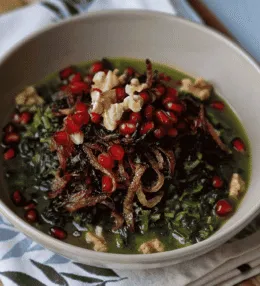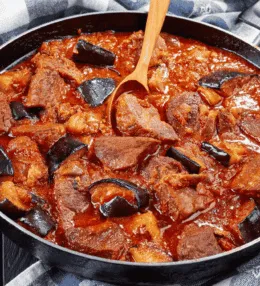
- View
Table of Contents
ToggleMustamakkara, Finland’s famous black sausage, is a dish that may raise eyebrows at first glance, but for locals, its pure comfort food. Hailing from the city of Tampere, this blood sausage is more than just a regional delicacy, it’s a proud symbol of Finnish culinary heritage with deep roots in tradition.
Typically eaten hot and fresh from the market stalls, Mustamakkara is often paired with lingonberry jam. The sharp fruitiness cuts through the richness of the sausage, creating a flavour combination that surprises newcomers and delights those who’ve grown up with it. It’s a dish that speaks to both the practicality and heart of Finnish cooking.
Want to dive deeper into Finnish Cuisine? Don’t miss our post on 22 Traditional Finnish Foods to Try
What Is Mustamakkara?
Mustamakkara is a dark, plump sausage made with pig’s blood, crushed rye, and barley. While that might sound unusual to those unfamiliar with blood based dishes, it’s a deeply rooted part of many traditional cuisines across Europe, and in Finland, this version has remained a firm favourite for generations.
The sausage is sold by length rather than weight, often cut straight from long coils and served piping hot in brown paper. While it can be pan fried or baked at home, the true experience is found at a local market stall in Tampere, where it’s cooked in large batches and served with care.
Ingredients and Taste
The main ingredients in Mustamakkara are pig’s blood, crushed rye, barley, and flour, which give the sausage its dense, hearty texture. The blood isn’t just a binding agent, it’s the key to the sausage’s deep colour and earthy richness, offering a savoury flavour that lingers without overpowering.
The texture is firm but tender, with a slightly grainy bite from the grains. When fresh and well prepared, the sausage has a juicy interior and a slightly crisped skin. The taste is iron rich, gently spiced, and unexpectedly mild, especially when balanced by the sweet acidity of lingonberry jam.
Mustamakkara is best eaten warm, ideally straight from the source. When paired with milk, a traditional choice, it becomes a full, satisfying meal that’s humble but deeply nourishing. The contrast between the sausage and lingonberries brings a surprising lightness to what might otherwise be considered a heavy dish.
A Taste of History
The origins of Mustamakkara date back centuries, rooted in the age old practice of using every part of the animal during slaughter. It was once common for Finnish households to prepare blood sausages during autumn slaughter season, ensuring nothing went to waste in a time before refrigeration.
While the basic idea of blood sausage exists across many cultures, Mustamakkara’s specific recipe and cultural weight make it distinctly Finnish. Tampere, its modern day home, embraced the dish fully, and today it stands as a point of local pride, attracting curious travellers and devoted regulars alike.
Though modern tastes have shifted, Mustamakkara has never faded from Finnish cuisine. It remains a popular street food, especially in its hometown, where locals still queue up in the cold to get their hands on a fresh portion. Its continued presence speaks to a culture that values resourcefulness, tradition, and flavour that tells a story.
Mustamakkara isn’t just food, it’s an experience that links Finland’s past with its present, offering a unique taste of a nation that embraces both bold flavours and deep rooted heritage.

Finnish Mustamakkara (Blood Sausage)
Ingredients
- 300 g fresh pork belly finely minced
- 200 g pork back fat diced small
- 250 ml fresh pig’s blood
- 100 g fine rye flour
- 50 g barley groats soaked in water for 1 hour, drained
- 1 small yellow onion grated
- 1 tsp salt
- ½ tsp ground allspice
- ¼ tsp black pepper
- Lingonberry jam to serve
Instructions
- To begin, soak the barley groats in cold water for one hour to soften. Drain thoroughly before use. Meanwhile, preheat your oven to 180°C (fan assisted) or 200°C (conventional). Prepare natural sausage casings by rinsing them under cold water and soaking them for 15 minutes in lukewarm water.
- In a large mixing bowl, combine the minced pork belly, diced pork fat, grated onion, and drained barley groats. Mix thoroughly using your hands to distribute the fat evenly, this helps achieve the traditional dense texture without breaking the casing.
- In a separate bowl, stir together the pig’s blood, rye flour, salt, allspice, and black pepper. Whisk gently until fully combined. Avoid whipping air into the blood, maintain a smooth and steady stir to preserve the sausage’s deep, rich colour.
- Slowly pour the blood mixture into the pork blend. Mix gently but thoroughly by hand until all ingredients are well incorporated. The filling should be cohesive and thick but pourable, adjust with a touch more rye flour if too runny.
- Using a sausage stuffer, carefully fill the soaked casings with the mixture, avoiding air pockets. Twist the sausages into links roughly 15–20cm long. Do not overstuff, leave room for expansion during cooking to prevent bursting.
- Bring a large pot of water to 80°C (not boiling). Gently poach the sausages for 20–25 minutes. Keep the temperature below simmering, this step sets the shape and texture without cooking the sausage fully.
- Remove the sausages from the water using a slotted spoon and place them on a wire rack to cool slightly. This resting period helps the casing firm up and allows excess moisture to escape.
- Transfer the sausages to a baking tray lined with parchment paper. Roast in the preheated oven for 45 minutes, turning once halfway through. They should be dark brown and crisp at the edges while retaining a soft centre.
- Allow the sausages to rest for 5 minutes out of the oven before serving. This prevents the casing from tearing when sliced and lets the flavours settle fully into the meat.
- Serve the mustamakkara hot, sliced thick, alongside a generous spoonful of lingonberry jam. For a traditional Finnish touch, pair it with rye bread or boiled potatoes. The tang of the berries balances the richness beautifully.
Nutrition
You May Also Like







Leave a Review